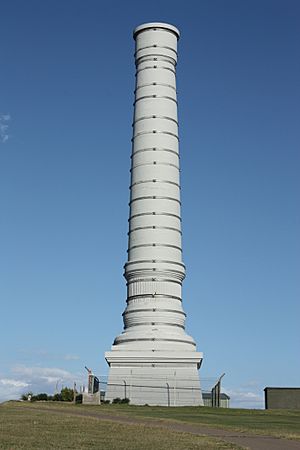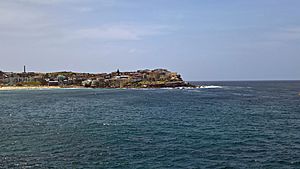Bondi Sewer Vent facts for kids
Quick facts for kids Bondi Sewer Vent |
|
|---|---|

Bondi Sewer Vent, pictured in 2010.
|
|
| Location | Military Road, North Bondi, Waverley Municipality, New South Wales, Australia |
| Architect | Metropolitan Board of Water Supply and Sewerage |
| Owner | Sydney Water |
| Official name: Sewer Vent (Ben Buckler); Ben Buckler; Earlier brick vent | |
| Type | State heritage (built) |
| Designated | 15 November 2002 |
| Reference no. | 1637 |
| Type | Other - Utilities - Sewerage |
| Category | Utilities - Sewerage |
| Lua error in Module:Location_map at line 420: attempt to index field 'wikibase' (a nil value). | |
The Bondi Sewer Vent is a tall, historic tower in North Bondi, New South Wales. It's a special kind of chimney that helps air move through the sewer system. This important structure was designed by the Metropolitan Board of Water Supply and Sewerage. It's also known by names like Sewer Vent (Ben Buckler) and Ben Buckler. The vent is owned by Sydney Water, a government agency. It was added to the New South Wales State Heritage Register on 15 November 2002 because of its historical importance.
History of the Bondi Vent
Why Sewer Vents Are Needed
In the late 1800s, engineers wanted to make sure air could move freely through the sewer pipes. This was important to stop bad smells and gases from building up. To do this, they built tall vent shafts, like chimneys, to let the air escape safely.
The First Vent Shaft
The first vent shaft at Bondi, near a place called Ben Buckler, was built in 1888. It was made of brick and stood about 17 meters (55 feet) tall. Other similar brick shafts were also built in places like Bellevue Hill and Glebe. However, this first brick vent at Bondi soon started to show cracks and problems.
Building the New Concrete Vent
Because the brick shaft was falling apart, a new design was created by the chief engineer, John Smail. In 1910, the old brick shaft was taken down. In its place, a new, stronger vent shaft made of reinforced concrete was built. This is the one you can still see today.
The new concrete shaft was very impressive for its time. It stood about 30 meters (100 feet) tall from the ground. It was built on a large base, about 6 meters (20 feet) high. The concrete was very thick at the bottom, about 42 centimeters (16.5 inches), and thinner at the top. It had strong steel bars inside to make it even stronger.
Keeping the Vent in Good Shape
Over the years, the Ben Buckler Vent Stack has needed a lot of repairs. This is because gases inside the sewer, especially hydrogen sulphide (H2S) gas, can cause the concrete to corrode and crack.
Here are some of the major repairs it has had:
- 1938: Parts of the inside concrete were removed because of gas damage and replaced with special bricks.
- 1948: Repairs were done to the brick joints that were damaged by the gas.
- 1963-65: Steel bands were added around the outside of the shaft to help strengthen it.
- 1977-78: The outside steel parts, like ladders and lightning protection, were replaced or fixed. Cracks were also repaired.
- 2000-01: More repairs were made to the outside surface, fixing cracks and adding a protective coating. New steel bands were also put on to help keep it stable.
What the Vent Looks Like
The Bondi Sewer Vent is a very noticeable structure. It stands out in the open landscape near the Bondi Golf Course and the ocean. You can see it from far away, making it a well-known landmark.
The shaft has a classic design, with a base, a main tower (the shaft), and a top part. It's made of reinforced concrete. You can see many steel bands wrapped around it from all the repairs over the years. It also has lights and lightning conductors.
Near the bottom of the shaft, there are concrete covers for access to the sewer chamber below. There are also some steel vents. A fence surrounds the base of the vent shaft.
On the south side of the base, you can read an inscription that says: "Metropolitan Board of Water Supply and Sewerage erected 1910". This tells us who built it and when.
Even with all the repairs and changes over time, the vent shaft is still mostly in its original form. The inside has been relined and repaired many times because of the gas damage.
Why the Vent is Important
A Landmark and Engineering Marvel
The Bondi Sewer Vent is a very important historical site. It's considered one of the most significant reinforced concrete structures of its kind in the Sydney Water system. It's a huge landmark that can be seen from a great distance, and many people in the community value it. It's also quite unique in New South Wales because of its design and how it was built.
Part of Sydney's History
The vent is one of the few visible parts of Sydney's first major sewerage system, built in the 19th century. It was also the first vent stack built using reinforced concrete by the Metropolitan Board of Water Supply & Sewerage. This shows how engineering was advancing at the time.
A Beautiful Design
The vent stack is a prominent landmark along the Bondi coastline. Its design shows the good taste and understanding of classic shapes and styles from that era.
Community Connection
Because it's such a well-known landmark and serves an important function, the vent stack is also important to the local community.
Learning from the Past
The vent stack helps us understand the early developments in using reinforced concrete, especially in sewer and structural engineering. It's a rare example of this type of construction in New South Wales.
A Common Function
While the Bondi Sewer Vent is unique in its design and history, its job of ventilating sewers is now a common and necessary part of modern sewage systems.


